
What is a buyer persona and how do I create one?
- Business Services
In the current digital space, personalized or targeted marketing is vital to producing successful campaigns; as part of this, it's now more essential than ever to have a good understanding of your customers.
By learning who your customers are, what they want, and what drives their decisions, you can tailor your messaging to their needs and wants, resulting in more conversions for your brand or business. But how can you achieve this level of understanding? Buyer persona’s are the key solution.
A buyer persona is a semi-fictional representation of your ideal customer, developed based on detailed market research and data about your existing customers. While traditional marketing might target broad demographic segments, buyer personas enable a more focused approach.
Buyer personas paint a vivid picture of who your ideal customer is, what they value, and how they make decisions - positioning you to view your customers as real people rather than an aggregation of demographic data.
But as powerful as traditional buyer personas can be when executed right and regularly maintained, they're not without limitations. In this article, we'll not only explore what a buyer persona is and why they're important, but we'll also explore the challenges and restrictions of traditional buyer personas. Most importantly, we'll introduce a more dynamic approach to buyer personas that leverages audience intelligence to overcome these limitations.
Ready to transform your understanding of your customers and supercharge your marketing strategy? Let's delve into the world of buyer personas.
Table of Contents
- What is a buyer persona?
- Definition of a buyer persona
- Why are buyer personas important to your business?
- How do I create a buyer persona?
- The limitations of traditional buyer personas
- The building blocks of traditional buyer personas: Demographics, behavior patterns, motivations, and goals
- The restriction of a static view: Why buyer personas need to be evolved
- Challenges of outdated data in creating effective buyer personas
- Audience segments: Redefining buyer personas
- Enriching buyer personas with audience intelligence
- Rethinking ‘what is a buyer persona?’ - Why audience segments are superior
What is a buyer persona?
While the concept of a buyer persona isn't new in the digital sphere, modern marketers are regularly looking for a way to evolve this traditional method of target marketing.
Buyer personas can be understood as fictional yet data-driven representations of an ideal customer, aiding businesses to understand and connect with their audiences in meaningful ways. Although buyer personas are rooted in reality and informed by actual data, they form imagined characters — creations that embody the qualities, behaviors, motivations, and goals of a significant segment of your audience.
By using buyer personas, businesses can empathize with their customers, tailoring their content, products, services, and overall strategy to meet their customers needs more effectively. A well-crafted, accurate persona can guide a business to substantial growth, while a misaligned or poorly researched persona can lead to misinformed strategies due to a lack of audience understanding.
Definition of a buyer persona
If we were to delve deeper, a buyer persona or customer, audience, or marketing persona, is a detailed profile that realizes and embodies a key segment of your target audience. These profiles aren't just a surface-level representation of traditional demographic data. Instead, a buyer persona encompasses the granular details of your customers' lives, thoughts and feelings.
Buyer personas encapsulate various elements, including demographic information like age, gender, location, and income, as well as psychographic information such as values, beliefs, and personality traits. But it doesn't stop there. Effective buyer personas also include insights into a customer's behavioral patterns, buying decisions, goals, challenges, and pain points.
Why are buyer personas important to your business?
Below, we'll outline the top three ways buyer personas are important to your business:
- Customer Insight: Buyer personas offer valuable insights into your customers' mindset, helping you understand their needs, motivations, pain points, and decision-making processes. This customer knowledge empowers you to design products, services, and strategies that align with your audience's expectations.
- Focused Marketing: Instead of spreading your efforts too thinly across a broad audience, buyer personas allow for more focused, effective marketing. They enable you to direct your marketing efforts to those most likely interested in your products or services to ensure you're not wasting resources by targeting the wrong people.
- Personalization: In today's online space, personalization is vital to customer engagement as personalized marketing is more likely to capture attention, and buyer personas provide the foundation for this. By understanding who your customers are, you can tailor your messaging and interactions to resonate with them, enhancing customer experience and curiosity, while also securing loyalty.
How do I create a buyer persona?
So, now you're better equipped with the knowledge of 'what is a buyer persona?' and why creating them is important for your business and marketing strategy - what about creating your own?
Crafting a robust and effective buyer persona is a multi-step process involving comprehensive research, data analysis, and ongoing refinement.
So, where do you start when attempting to create traditional buyer personas?
- Research: Begin with a thorough understanding of your existing customers. Use market research, customer surveys, and data analytics to gather information about your customer demographics, behavior, preferences, and needs.
- Segmentation: Segment your audience based on different factors such as demographics, behaviors, and motivations. From this, you can then refine each segment into a specific persona.
- Characterisation: Develop a detailed profile for each persona. Each profile should include demographic details, psychographic information, motivations, pain points, and buying behavior. The more detailed your persona, the better you can understand them.
- Refinement: Buyer personas are not static; they should evolve with your business and market changes. In order to ensure your buyer personas remain accurate and insightful, it's vital to regularly update your profiles based on new audience data and feedback. Creating buyer personas is not a one-time activity but an ongoing process that requires regular review and updating to remain relevant.
While when done effectively, traditional buyer personas can prove a valuable marketing aid, it's vital to acknowledge the limitations of this approach. In the subsequent section of this article, we'll delve into why these conventional buyer personas may not fully capture your audience's complex and nuanced narratives. By recognising these limitations, it becomes easier to pave the way to introduce more innovative and dynamic methods of understanding your customers.
The limitations of traditional buyer personas
So what are these limitations exactly? And, what do traditional buyer personas miss?
Traditional buyer personas, while helpful, are not without their restrictions. Although they provide a static and potentially outdated representation of your customers, they often fail to reflect the ongoing changes in consumer behavior and market trends. This static nature can lead to a restrained view of your customer base, ultimately hindering your marketing strategy.
Let's dive deeper into these limitations and how a more dynamic approach can overcome them.
The building blocks of traditional buyer personas: Demographics, behavior patterns, motivations, and goals
Before we delve into these building blocks, it's essential to understand how we gather the data that shapes traditional buyer personas. The data gathering often involves a combination of research methods, including surveys and interviews with your current and prospective customers, as well as your potential audience.
You can distribute surveys to your existing customer base or a broader target audience, and these work to capture essential data about demographics, behaviors, motivations, and goals. At the same time, in-depth customer interviews can provide insights that help construct the persona in more detail, uncovering stories, experiences, and sentiments, easy to miss in a survey. Feedback from your sales and customer service teams, as they interact directly with your customers, can provide invaluable insights into customer motivations and goals.
Yet, while these research methods can provide rich insights, they also highlight the limitations of traditional buyer personas. Surveys and interviews require significant resources, but the data gathered can become outdated in a rapidly evolving market. And, despite the work that goes into building traditional buyer personas, they can still end up oversimplified representations of the audience.
Generally, the foundation of these personas consists of four key building blocks: audience demographics, behavior patterns, motivations, and goals. Each plays a role in establishing a representation of your ideal customer. But each also comes with limitations that can restrict the understanding of your audience necessary to build a successful marketing strategy.
Now, let's explore the pillars of personas and how their limitations contribute to the overall drawbacks of traditional buyer personas.
- Firstly, audience demographics provide general attributes such as age, gender, geographical location, income bracket, education level, and occupation. But this approach can often restrict us to a surface-level understanding of our audience. Basing decisions solely on demographic data can risk assuming shared affinities within a group that might not exist, neglecting the uniqueness and complexity of individual identities.
- Behavior patterns such as lifestyle choices, consumer habits, online activities, and brand interactions provide valuable insight into how our audience acts. However, these are often based on past and current actions and may not fully reflect the evolving nature of consumer behaviors and trends, risking the potential of outdated and inaccurate personas.
- Motivations are another cornerstone of traditional personas, including values, fears, desires, and challenges. The drawback is that motivations are often deep-seated and complex, and capturing them as felt can be challenging using traditional methods.
- Lastly, it's vital to take into account our personas goals. These can range from personal ambitions to professional objectives. But aspirations can shift over time due to various factors, and static personas may struggle to keep up with these changes.
While these components form the basis of traditional buyer personas, they also expose their inherent limitations. They often provide a static snapshot rather than a dynamic picture, struggle to accommodate evolving trends, and can potentially oversimplify our audience's rich diversity. So, how can we overcome these limitations?
The restriction of a static view: Why buyer personas need to be evolved
Keeping up with the digital world's pace can be challenging, particularly when maintaining compelling marketing efforts. An essential aspect of this is ensuring your buyer personas are kept up-to-date. The creation and maintenance of traditional buyer personas can be a considerable undertaking with little payoff unless done right.
Creating a traditional buyer persona requires a comprehensive understanding of your target audience. It involves careful research and thought-out strategies to depict your ideal customers effectively. However, this substantial effort could prove redundant without proper maintenance and updates.
Each day, social media networks and other online platforms are abuzz with new conversations, opinions, and ideas. This constant online activity shapes and evolves our audiences rapidly, and it's no surprise that your static buyer persona can quickly become outdated in this dynamic environment.
While a traditional buyer persona provides a valuable snapshot of your audience at a specific moment, it remains static. In other words, it doesn't evolve as your audience does. This limitation is critical to recognise as we explore the potential of buyer personas and the role of audience intelligence in creating a more dynamic view of your audience.
Challenges of outdated data in creating effective buyer personas
People's attitudes, behaviors, and circumstances change over time. They gain new knowledge, form fresh opinions, and undergo various life changes - from starting families to transitioning jobs. These shifts often influence their online activity, including interactions with brands or services and purchasing habits.
If you're not updating your buyer personas regularly to account for these changes, they become increasingly outdated and less effective. Essentially, you're creating blind spots in your marketing strategy, potentially targeting the wrong audience or overlooking key segments.
In the fast-paced world of digital marketing, data and audience understanding need to be current and dynamic. In the next section, we'll look at how you can overcome these challenges and move beyond traditional buyer personas with a more dynamic and real-time approach.
Audience segments: Redefining buyer personas
If traditional buyer personas aren't the answer - what is? The solution lies in the realm of audience intelligence and audience segments. Through tools like Pulsar TRAC, you can harness real-time audience tracking to stay up-to-date with your audience, capturing shifts in behavior and sentiment as they unfold.
While traditional buyer personas focus on historical data, audience intelligence uses real-time data for precise, up-to-date audience understanding. But the power of audience intelligence doesn't stop there. Beyond real-time insights, audience intelligence extends far beyond traditional demographic data by offering deep insights into audience behaviors, interests, and values. This level of detail enables brands and businesses to go granular and create more nuanced and dynamic buyer personas that accurately reflect their audience.
With this in mind, evolving and redefining the concept of buyer personas through the lens of audience segments becomes simple.
Enriching buyer personas with audience intelligence
As we've discussed, traditional buyer personas, despite their limitations, are valuable tools when building a marketing strategy. Yet, Pulsar TRAC makes it easy for marketers to enhance their buyer personas by integrating dynamic audience segments built upon real and actionable data.
Let's delve deeper into how these look in a practical context.
By using Pulsar TRAC to investigate the online conversations around sustainability, we can unveil insightful details about the people most highly engaged with this topic. This exploration gives us a glimpse of the demographic characteristics of those actively involved in 'sustainability' conversations online:
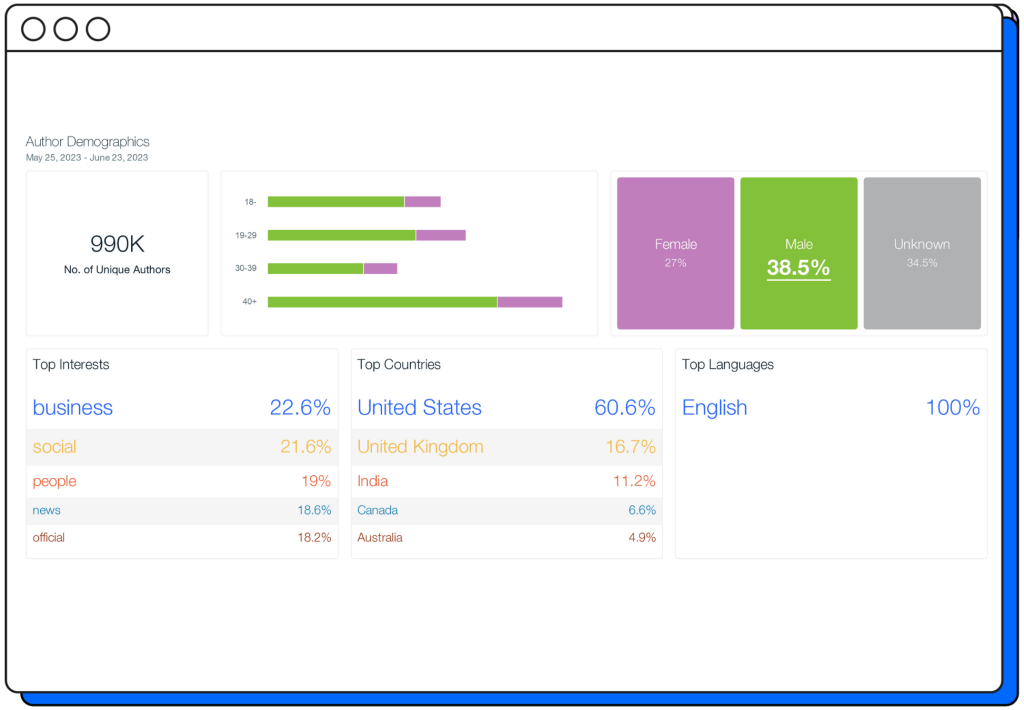
The intelligence gathered from Pulsar TRAC, as shown in our exploration of sustainability discussions, doesn't replace these personas but augments them. Implementing audience intelligence is not a transition from buyer personas to audience segments but a merge of the two, enriching our traditional buyers with dynamic, real-time insights. In simpler terms, we retain the concept of a 'buyer persona' but redefine it.
While this is merely the first step towards crafting your audience segments, it’s vitally important. It sheds light on base-level information essential to getting to know your audiences, such as gender distribution, age groups, top interests, geographical locations, and spoken languages of your audience. For more on understanding demographic data, head to our blog post on audience demographics analysis.
But how do we go beyond this baseline data to create a more nuanced understanding of our audience?
Next, we delve into the 'Communities' feature within Pulsar TRAC, which reveals the top audience segments engaged with the sustainability topic based on their active participation in online discussions. At a glance, the most engaged communities include 'Advertising Agencies', 'Climate Activists', the 'Global Fashion Industry', and 'Anti-Environmentalists'.
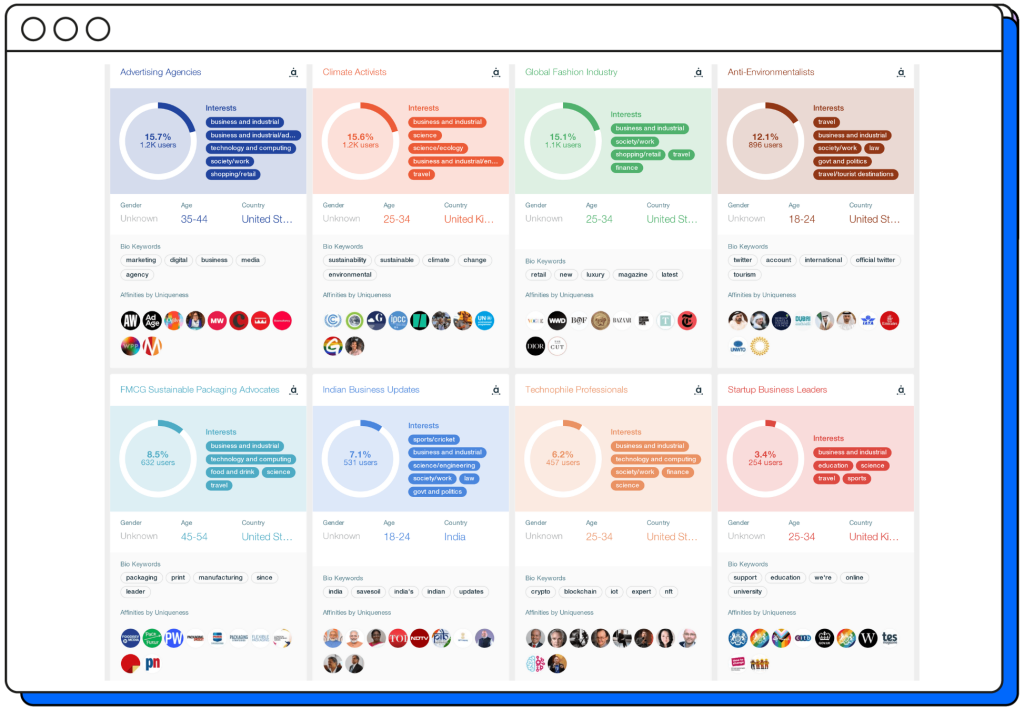
While some segments, such as 'Climate Activists' and the 'Global Fashion Industry', naturally align with the sustainability topic, the data also reveals unexpected insights that only become apparent when aided by audience intelligence.
Notably, 'Advertising Agencies' emerged as the dominant audience segment, indicating a possible increase in marketing, advertising, and PR efforts to position brands within the eco-friendly sphere. This segment may reflect the growing public interest in sustainability and environmentally responsible practices.
Interestingly, 'Anti-Environmentalists' also feature prominently, indicating a significant countermovement to the sustainability conversation on social media. These findings illustrate how a dynamic approach to buyer personas can uncover complex and evolving aspects of audience engagement that traditional personas may miss.
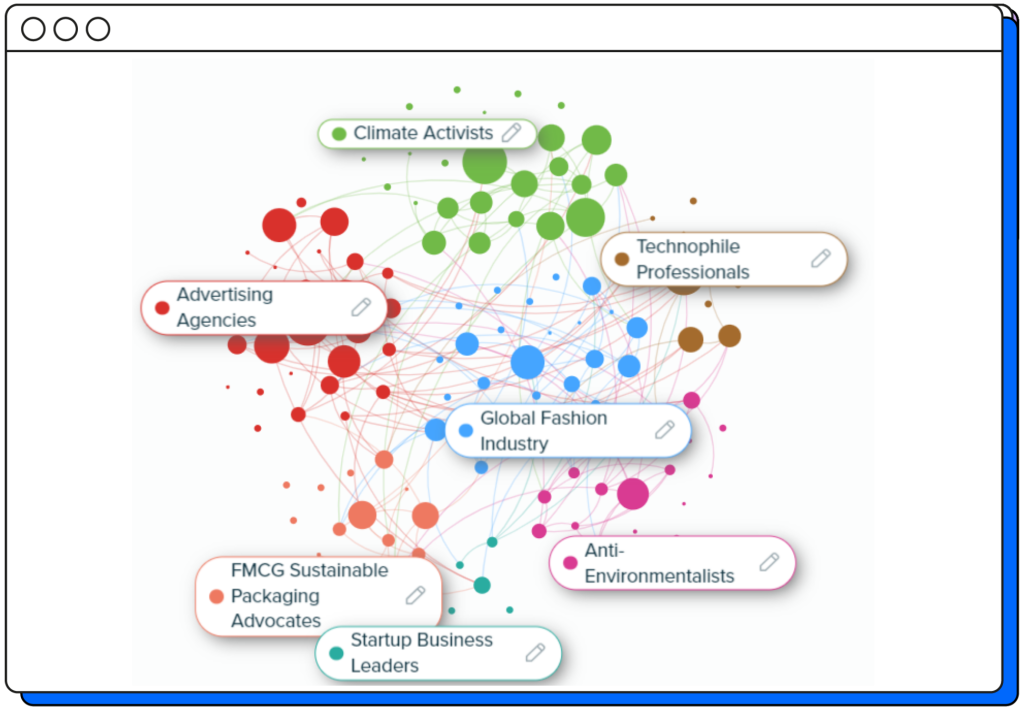
The chart above visually represents the most engaged audience segments in the sustainability conversation and the extent of their interaction and dominance on social media. It's clear from the visualization that 'Advertising Agencies' and 'Climate Activists' are the most dominant segments within this conversation. The connecting lines between various communities and differing bubble sizes signify their interconnectedness.
Pulsar TRAC presents an opportunity to dig deeper into the unique insights for each segment. Data concerning a 'buying mindset' can be particularly enlightening, enabling you to fine-tune your marketing strategy and offer a more personalized experience for each segment. This bespoke approach can significantly enhance conversion rates as you provide each community with the online experience they seek.
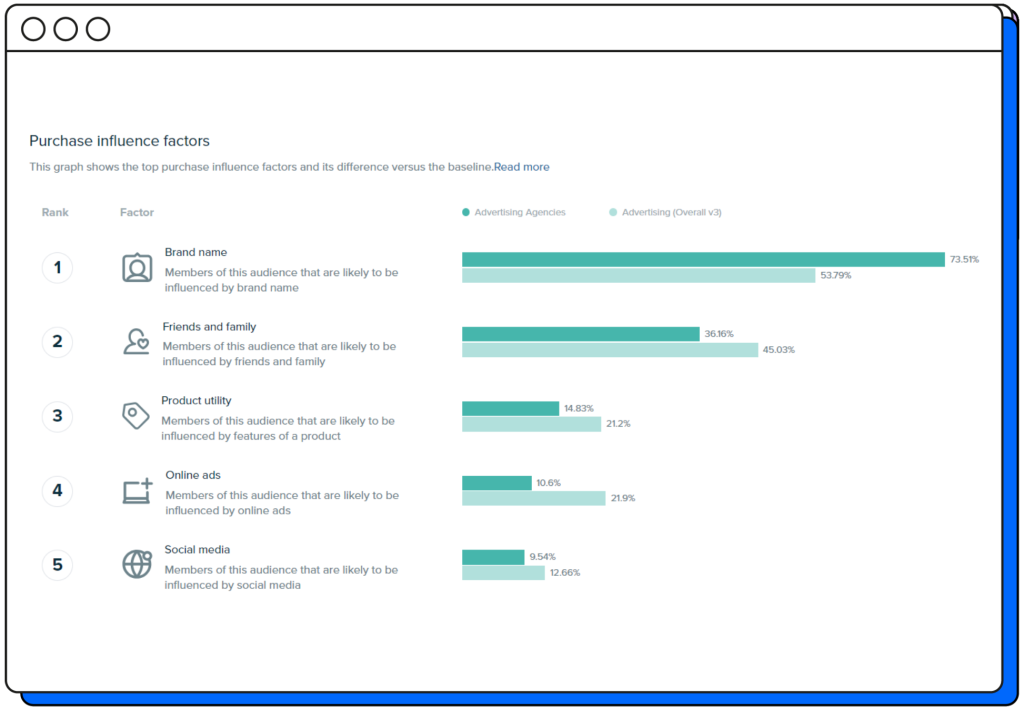
The chart above shows individuals within the 'Advertising Agencies' segment are most likely influenced by brand names and recommendations from friends and family. On the other hand, 'Climate Activists' are generally influenced more by friends and family or online ads. With this level of detail, you can fine-tune your advertising strategies for optimal success, whether targeting specific audience members with social media ads or integrating the brand name more frequently into your messaging.
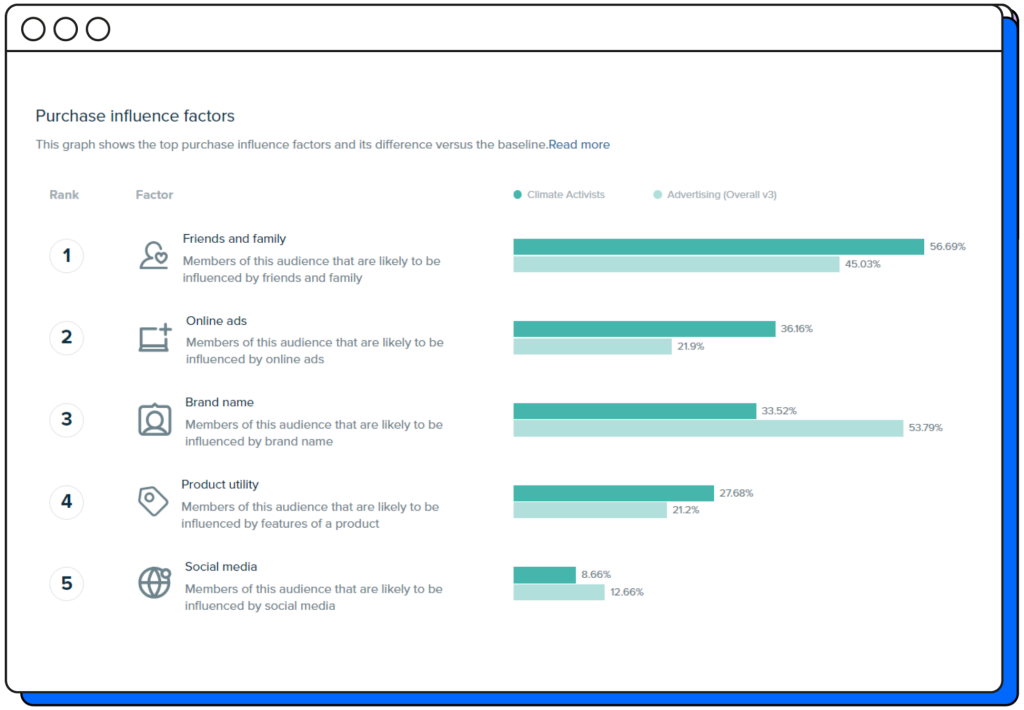
The transition from traditional buyer personas to dynamic audience segments provides marketers with an unparalleled depth of understanding, illuminating their audience's behaviors and motivations. With these insights, brands and businesses can craft effective, personalized marketing strategies.
By merging traditional buyer personas with dynamic audience segments, we aren't moving away from or replacing an old approach but evolving it. This evolution keeps us ahead of the curve, enabling the creation of targeted, relevant, and impactful marketing campaigns.
Rethinking ‘what is a buyer persona?’ - Why audience segments are superior
Understanding your audience and meeting their needs and interests in your marketing efforts is crucial for modern-day marketing success.
As outlined in this article, traditional buyer personas often fall short of capturing the dynamic nature of modern audiences due to the static snapshot they provide.
A far superior approach is to enrich your personas with audience segmentation. By harnessing the power of audience intelligence and adopting a segment-focused approach, marketers can craft a more personalized and effective alternative that evolves traditional buyer personas.
The journey from traditional buyer personas to dynamic audience segments marks an evolution in understanding our audiences. By embracing this augmented approach, marketers can stay ahead of the curve, delivering targeted, relevant, and impactful marketing campaigns that resonate with their audiences
